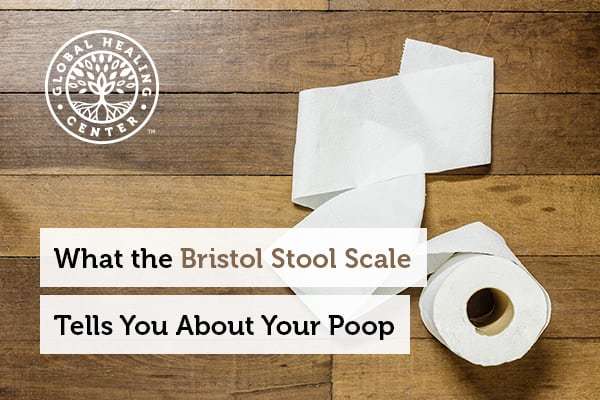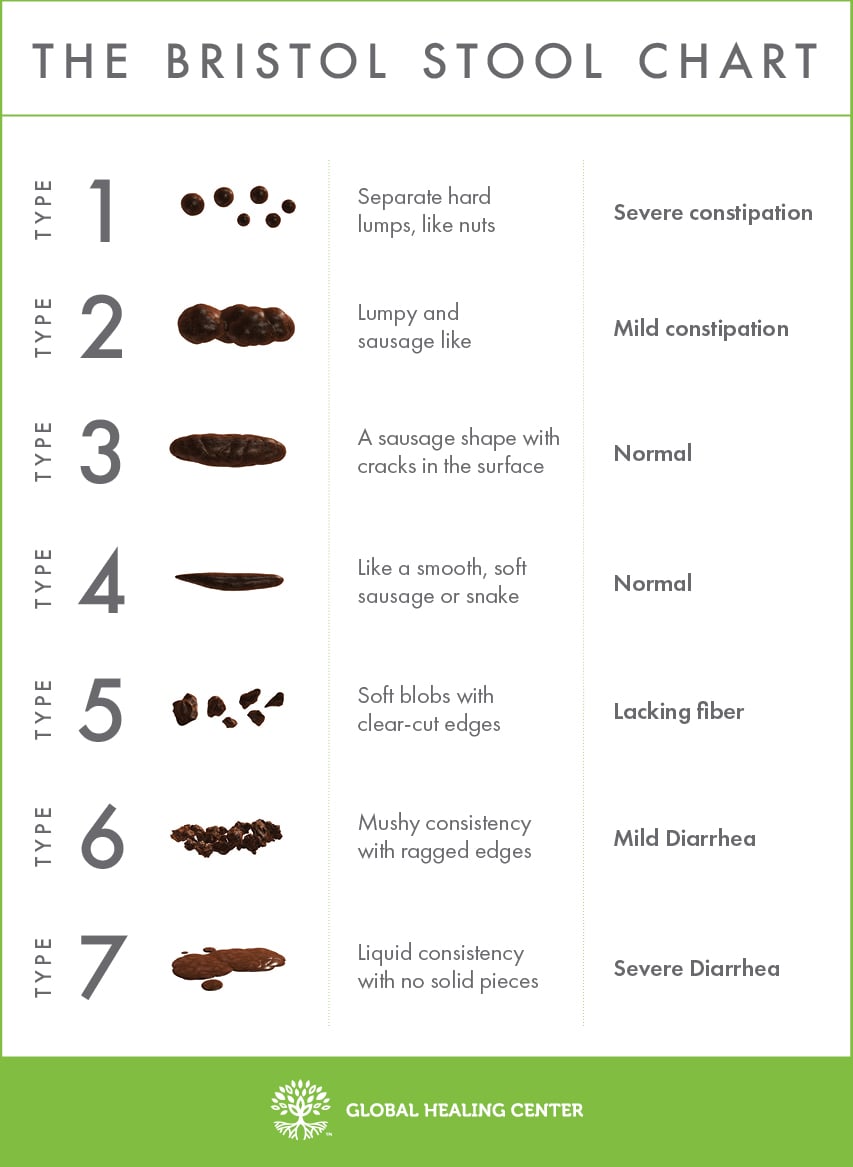
Your poop is an important indicator of how your body is running and your current health status. While using the appearance of your poop to gauge your wellness may seem strange to some, it is a medically proven way to detect an imbalance in your gut and disruptions to your digestive health. If you want to measure your health by your poop, then the Bristol Stool Scale is one of the best tools to use.
What Is the Bristol Stool Scale?
The Bristol Stool Scale, sometimes called the Bristol Stool Chart or Bristol Stool Form Scale (BSF), was first developed in England by Dr. Stephen Lewis and Dr. Ken Heaton at the Bristol Royal Infirmary. Initially, it evaluated the effectiveness of bowel diseases treatments, but since then it has been used more broadly as a diagnostic tool for general digestive health.
The charts itself breaks down bowel movements into seven different categories. Each type notes the appearance of the stool along with the associated health status. Below is the Bristol Stool Chart in its entirety.

What the Bristol Stool Scale Tells You About Your Poop
The Bristol Stool Scale uses the appearance of your poop to help you determine what is going on inside your digestive system. By identifying your stool form, size, and consistency, you can match it with a Bristol Stool Scale “type,” and gauge your general digestive health status.
Type 1 Constipation
Type 1 is hard stools that appear in separate lumps, similar to nuts. They have a longer colon transit time and can be difficult to pass. Type 1 stools are a sure sign that you’re constipated.
Type 2 Constipation
Type 2 stools are lumpy, hard, and have a sausage-like appearance. They indicate constipation, toxic overload, and the need for intestinal cleansing.
Type 3 Normal
Type 3 stools have an appearance similar to a sausage but smoother and with surface cracks. Type 3 is considered normal stools.
Type 4 Normal
Type 4 stools are smooth and soft in the form of a sausage or snake, and like Type 3, also considered normal.
Type 5 Lacking Fiber
Type 5 stools are soft blobs with clear-cut edges that pass quickly. They are a kind of soft diarrhea. Type 5 may be a sign your diet is lacking fiber or of a toxic overload in your system.
Type 6 Diarrhea
Type 6 stools have fluffy pieces with ragged edges. These are mushy and almost resemble diarrhea. These stools are a sure sign of toxic overload.
Type 7 Diarrhea
Type 7 consists of soft, watery stools with no solid pieces. This kind of stool has spent the least amount of time in the colon and may indicate a bacterial or viral infection.
How to Use the Bristol Stool Scale
Using the chart to determine where your poop falls is pretty straightforward. Go to the bathroom, and then take a look into the toilet at your poop. You can match what you see on the scale to which type your poop most closely resembles. While there are some variations, the Bristol Stool Scale will help you identify your stools more often than not. If your stool is anything besides Type 3 or Type 4, then you may want to consider adjusting your diet or lifestyle to help normalize your bowel movements.
When to Consult Your Healthcare Practitioner
Listening to what your poop is trying to tell you is crucial. In some cases, your bowel movements can indicate serious health concerns that may require a visit to your trusted healthcare provider. Chronic constipation lasting for days or weeks may be a sign of bowel disease. Likewise, extremely loose stools or diarrhea lasting longer than 24 hours can cause dehydration and may be a sign of serious health concerns like irritable bowel syndrome (IBS). If you are experiencing painful bowel movements or blood in your stool, then it should be evaluated by a doctor.
Other Ways to Monitor Your Digestive Health
Beyond the Bristol Stool Scale, there are other ways to monitor your bowel movements. Here are the most helpful things to observe when self-evaluating your poop.
Frequency
On average, adults have one bowel movement a day. That means anything from three times a day to three times a week is considered normal. However, an optimal bathroom routine is closer to two or three times per day. Less frequent than that and you may be experiencing occasional constipation. More than three times a day and you may be experiencing diarrhea or a digestive infection.[1]
Smell
How your stool smells is one way your body communicates the status of your inner health. Foul smells may suggest toxicity. However, it is normal to have a bad smelling poop. Usually, the fragrances are merely the result of bacteria in your body that help break down your food. What you should be watching out for most are drastic changes in the smell of your poop. These changes can indicate more significant health concern or disease at play.[2]
Color
The color of your stool paints a clear picture of what is happening inside your body. While there are many shades of brown that are considered healthy, there are a few other hues best avoided.[3]
Green
Not every shade of green is terrible. Certain vegetables like kale and spinach can cause your poop to appear green. However, consistently green stool can be a sign that food is passing through your digestives system too quickly, skipping a slower more controlled transition which often turns the feces from green to brown.[4]
Red
Red feces is not always a cause for alarm, but it can be scary when you don’t know the source. There are innocuous causes, such as eating beets, but red poop can also be an indication of intestinal bleeding. If you are experiencing red stools caused by internal bleeding, seek immediate medical attention.
White
White colored stool is a sign of severe digestive issues. Typically, they are caused by a lack of bile. Bile is an essential digestive fluid produced by the liver and gallbladder and contributes to the brown color of your stool. If bile production has slowed or stopped, other health concerns are likely, and you should consult a trusted healthcare provider.
Yellow
Yellow is an abnormal stool color, and typically is a sign of internal issues. Common causes of yellow poop include liver disorders, celiac disease, and intestinal infections. Temporary causes of yellow bowel movements can include food coloring and eating foods like carrots and sweet potatoes.
How to Improve Your Digestive Health
The health of your poop is a reflection of your overall wellness. When your body is functioning normally, there are rarely issues with your poop. Many of the ways to improve your bowel movements are the same advice for supporting your overall health. Because everything in your body is so intimately connected, as you make healthier lifestyle choices you will start to see and feel the difference both in and out of the bathroom.
Change Your Diet
Consistently eating healthy, raw food is critical to supporting your digestive system. Eating a plant-based diet can provide the vitamins, minerals, and other nutrients your body needs. The right mix of fruits and veggies can also provide fiber and water to support regularity. Make sure to look for certified organic food that doesn’t contain harmful pesticides and chemicals that can weaken your digestive system.
Add Probiotic-Rich Foods
Bacteria play a key role in your digestive health. Healthy bacteria in your gut and colon break down food and promote a healthy balance inside your digestive system. Eating probiotic-rich foods like kombucha and kimchi will help multiply the good bacteria in your body and push out the harmful ones.
Drink More Water
The importance of water cannot be overstated. It keeps you hydrated and encourages healthy bowel movements. Be sure to drink purified and distilled water only. Drinking these types of clean water eliminates the risk of ingesting harmful toxins that are far too common in unfiltered tap water.
Avoid Toxic Foods
While moderation is an essential aspect of any healthy diet, some foods should always be avoided. Dairy, meat, and refined sugars can cause constipation and digestive stress. It may be a good idea to also cut out gluten unless you know for sure you do not have a gluten sensitivity or allergy.
Try a Cleanse
Your digestive system is bombarded every day by toxins and harmful organisms. If you’re not eating organic, then you are likely consuming chemicals and pesticide residue left on your food. Over time, these toxic substances can build up along your digestive tract and cause issues with your poop.
Cleanses and organic detoxes are useful resources to expel these toxins from the body. Global Healing Center offers natural and organic cleanses to support a healthy gut, colon, and intestines. The foundation of all of these cleanses is an all-natural intestinal cleanser called Oxy-Powder®, which uses the power oxygen to cleanse the entire digestive tract. It has also helped millions of people put a stop to occasional constipation, bloating, and other annoying digestive issues.
Your Story
Have you used the Bristol Stool Scale to determine the health of your poop, or tried an intestinal cleanse? Tell us about your experiences in the comment section below.
The post What the Bristol Stool Scale Tells You About Your Poop appeared first on Dr. Group's Healthy Living Articles.
source https://www.globalhealingcenter.com/natural-health/the-bristol-stool-scale/
No comments:
Post a Comment